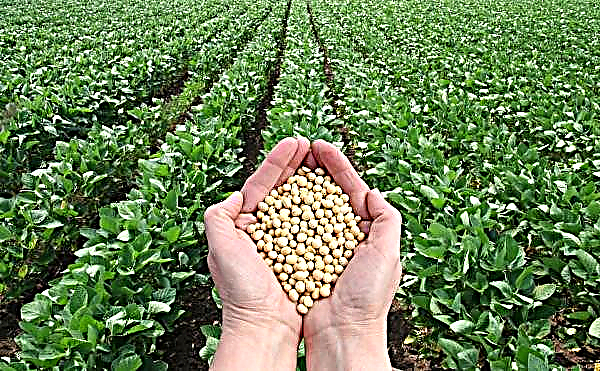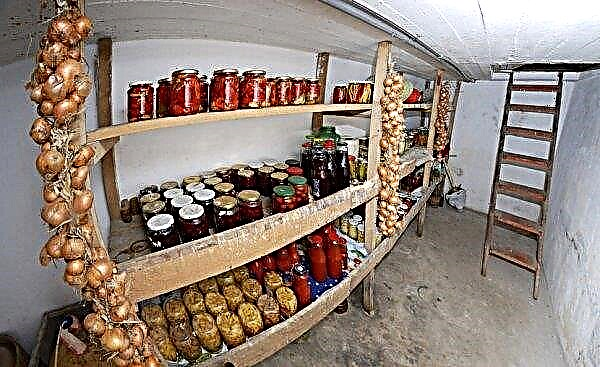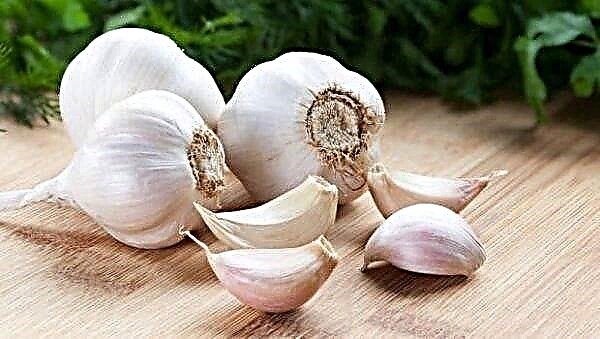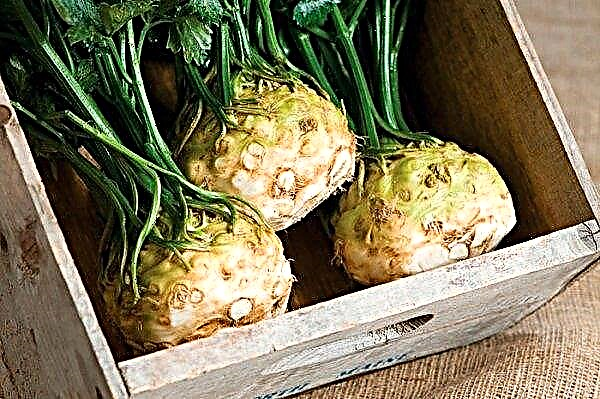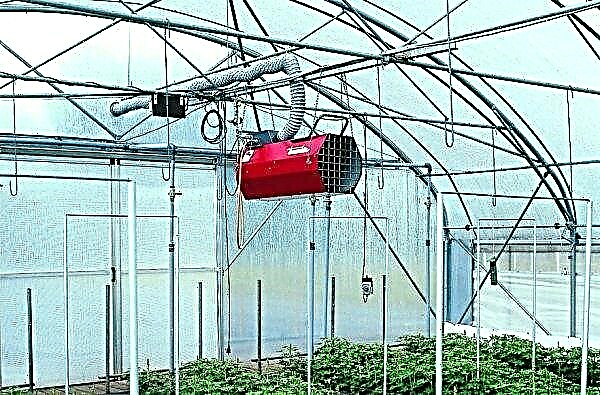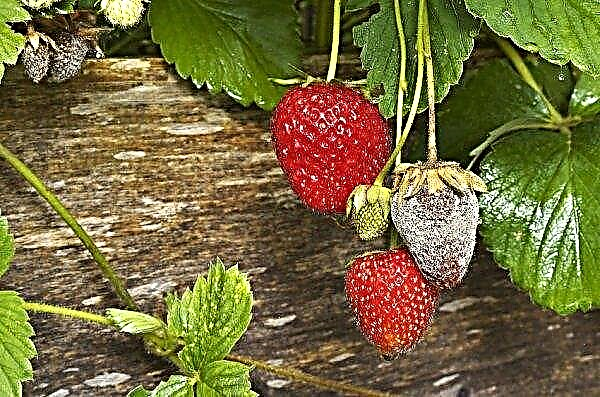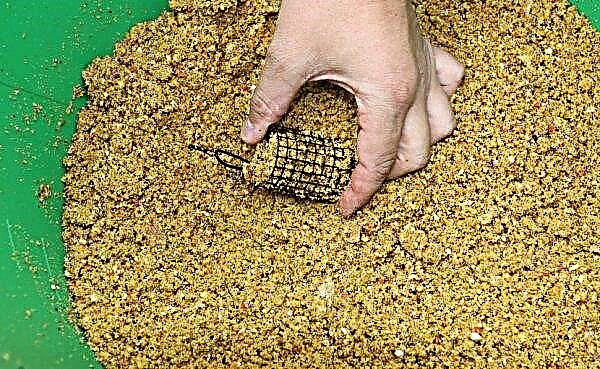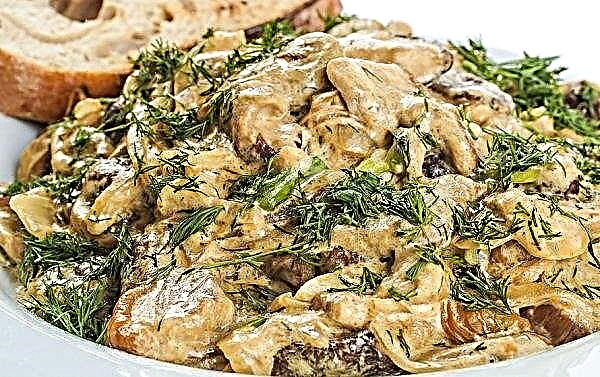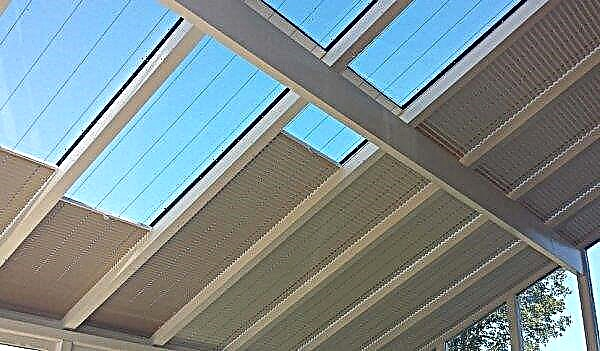Red currant is a tasty and healthy berry. In this article, you will learn about the Rosetta variety (Rosetta), or as Rosita is also called, its advantages and disadvantages, as well as the basics of caring for it.
Rosetta Variety Description
Fertile bushes with large berries, which contain many useful substances. Rosetta redcurrant tolerates dry weather, and can also winter without hiding.
Selection history
The variety was obtained thanks to Novosibirsk breeders by crossing the Red Cross and Minnesota back in 1980. It was entered in the register in 2004 and is allowed for cultivation only in the Siberian region.
Did you know? Essential oils made from berries have an antimicrobial effect and also protect the human body from diseases.
Appearance, characteristics of berries, ripening time, yield
Shrub is not very tall, not sprawling. The branches are quite dense, do not bend under the weight of the berries. Leaves are not large, dark green in color. Fruit-bearing brushes do not exceed a length of 10 cm. The flowers are light, almost white, a slightly pink hue is slightly visible.
Description of berries:
- sweet, with a slight acidity;
- have a red tint;
- round;
- the skin is thin, but, despite this, the fruits are quite dense;
- have a fragrance;
- the average weight of the fetus reaches 1.2 g;
- contain a large amount of vitamin C;
- have a characteristic luster on the surface of the berries.
Fruits on the brush ripen almost evenly towards the end of July. If you carry out quality care for shrubs, you will be able to collect about 3.5 kg from one bush.
Did you know? By consuming 40 currants per day, you replenish the daily supply of vitamin C in the body.
Advantages and disadvantages of the variety
Like all varieties, it has its own advantages and disadvantages.
- Rosette Benefits:
- resistant to severe frosts;
- tolerates heat and drought;
- the fruits are large enough;
- shrubs do not grow too large;
- berries are suitable for desserts, as well as suitable for transportation.
- Cons of the variety:
- often affected by anthracnosis;
- grows poorly in areas where high humidity.
Agricultural technology
Rosetta is not picky about leaving, but do not forget that it is important to carry out agricultural activities. Since this will allow you to get more yield, and the plant will grow. It is necessary to weed after rains and watering the soil, and also to remove weeds in time, which draw moisture out of the soil.
Seat selection and landing
The place for planting red currants should be chosen so that the groundwater is as low as possible. Rosetta does not tolerate excessive moisture. Thanks to a well-developed root system, it can tolerate severe drought. The place should be well-lit, currants do not like shade, so planting under large trees should be abandoned. Landing is preferably carried out in chernozem, sandy soils are not suitable for currants.
Landing is preferably carried out in chernozem, sandy soils are not suitable for currants.
Landing is preferably carried out in early spring, when the air temperature will be above + 10 ° C, this will allow the plant to take root well in winter.
Before planting in open ground, you should prepare the soil, for this the first thing is to remove the weeds and dig the site. 10 kg of humus or manure are applied per 1 m², as well as serial potassium and superphosphate of 90 g each. It is advisable to apply such fertilizers 3 weeks before planting currants, during which time they will mix with the ground.
Important! Before starting planting seedlings, it is recommended to place them in water for a couple of hours, so they will gain the necessary amount of moisture.
Care
Regular watering is carried out only in the first month after planting, moisture is applied every 3-4 days for 1 bucket of water. The next watering is done in the summer in July and autumn in October, 4 buckets of water per bush. If the summer turned out to be arid, you can water the plant a couple of times, but not fill it, as Rosetta does not tolerate excessive moisture.
At the beginning of spring, urea should be added, 20 g of this top dressing will be enough for 1 m². Next, litter is made, bird or cow, the first one will need 1 kg per 17 liters of water, and the second - 1 kg per 9 liters of water, also per 1 m² of soil. Litter should be made during the flowering period of the plant. After harvesting, 100 g of ash is made per 1 bush of currant. In October, you will need to put humus under the bushes, 1 bucket on 1 bush.
Pest and Disease Control
Pests of redcurrant:
Rosetta's Diseases:
- anthracnose. This is a fungal disease, due to which yellow spots begin to appear on the leaves, as a result, they crumble. Spraying is carried out before the buds have not yet blossomed, and after harvesting with the Kuprozan and Ftolan preparations. In order to also protect the plant, one should regularly check the leaves: those that are affected by the fungus should be removed, and the plant should be watered as necessary and make sure that the water does not stagnate under the bush;

- terry currants. The currant branches cease to develop, and after flowering in the place of flowers appear small balls of a purple hue, slightly fluffy. If you notice terry, immediately remove the bush completely from the plantation and burn it, this will protect the rest of the plants.

Important! In order to protect themselves and their plantations, it is advisable to buy seedlings from trusted sellers who can give guarantees for currants.
Trimming and shaping a bush
Immediately after planting, the tops of the shrub should be trimmed and a few buds should be left on the trunk. This procedure will make the currant not too tall, and the bush will look neat. Fig. 1. Currant pruning: a - annual seedling; b - a biennial bush; c, d - shortening of shoots. Fig. 2. Currant bush before anti-aging pruning (a), after it (b) and pruning of a neglected bush (c).
Fig. 1. Currant pruning: a - annual seedling; b - a biennial bush; c, d - shortening of shoots. Fig. 2. Currant bush before anti-aging pruning (a), after it (b) and pruning of a neglected bush (c).
In the spring, dry branches should be cut every year, those that are already bearing fruit for 6 years or more, as well as weak ones. In total, no more than 20 branches should remain on the bush. This will allow new branches to appear and will give an opportunity to grow currants normally.
Wintering
This variety of red currant calmly tolerates temperatures up to -30 ° C, so you should not cover the plant. It is enough to remove weeds and other garbage near the bushes, as well as to mulch the soil, for this you can use sawdust or pine needles and branches.

Harvesting and transportation of the crop, shelf life of berries
After collecting the berries, you can store up to 10 days in a cool and dry place, a refrigerator or a barn is suitable. Fruits of Rosetta red currant are universal in application, they can be frozen, consumed raw, and various jams can be prepared. During transportation, the berry does not lose shape and does not flow, but it should be transported in special bags that do not release cold, this will preserve the freshness of the fruit.
It is easy and simple to grow beautiful shrubs of Rosetta red currant, the main thing is to follow some rules. Regular top dressing and agricultural activities will improve productivity and protect the plant from diseases and pests.



